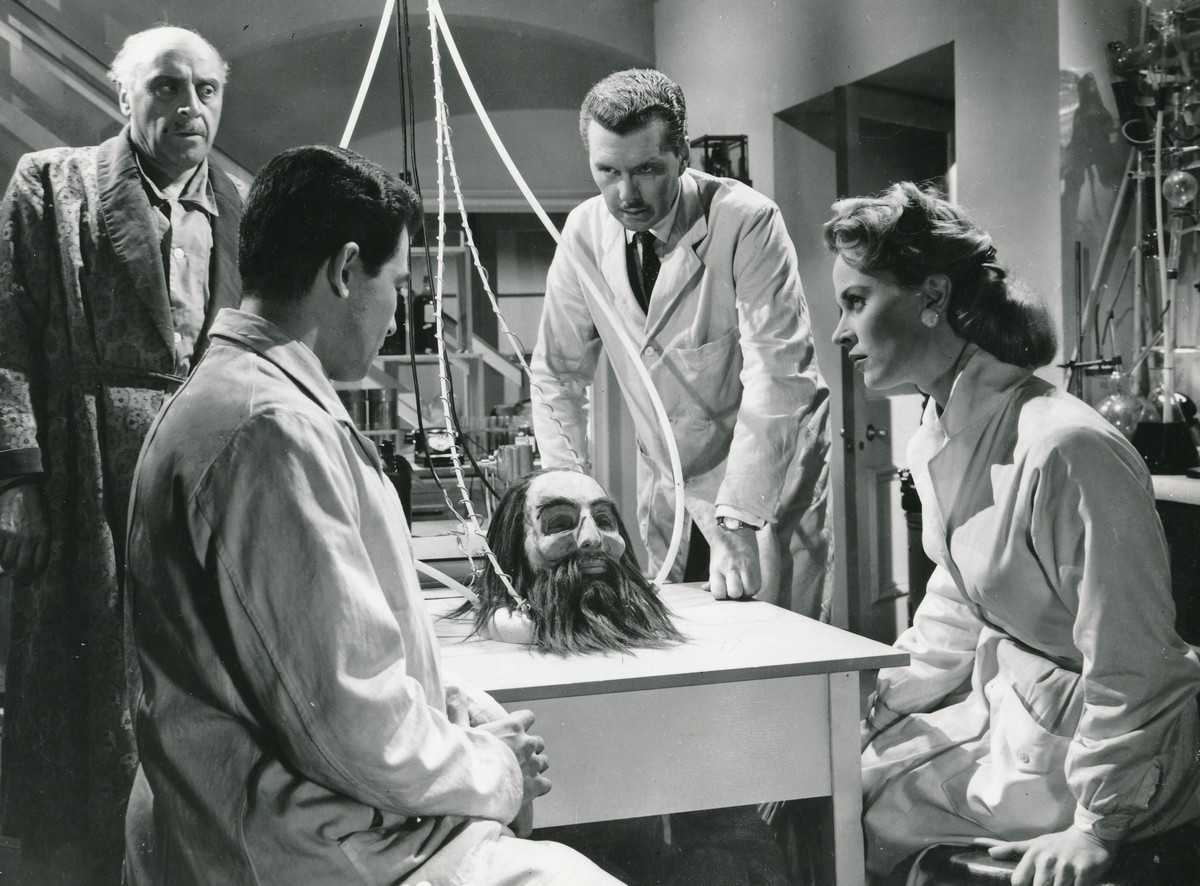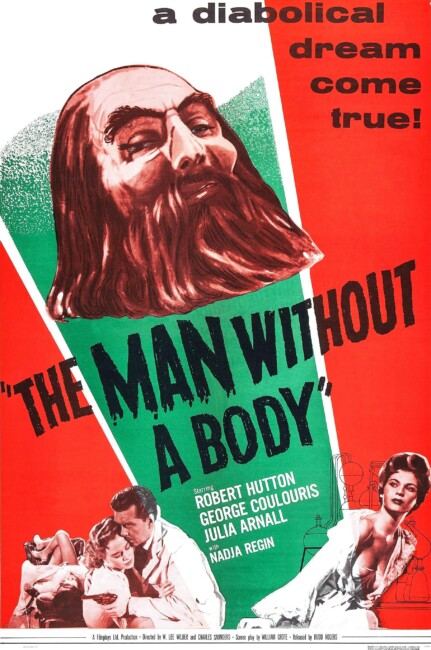Crew
Directors – Charles Saunders & W. Lee Wilder, Screenplay – William Grote, Producer – Guido Coen, Photography (b&w) – Brendan Stafford, Music – Albert Elms, Art Direction – Harry White. Production Company – Filmplays Ltd.,.
Cast
George Coulouris (Karl Brussard), Robert Hutton (Dr Phil Merritt), Nadja Regin (Odette Vernet), Julia Arnall (Jean Cramer), Sheldon Lawrence (Dr Lew Weldenhouse), Peter Copley (Leslie), Michael Golden (Nostradamus), Norman Shelley (Dr Alexander), Tony Quinn (Dr Brandon), William Sherwood (Dr Charot), Maurice Kaufman (Chauffeur)
Plot
Successful businessman Karl Brussard has been diagnosed with a terminal condition. Seeking a cure, he goes to American scientist Dr Phil Merritt who demonstrates that he has managed to keep severed animal heads alive in his laboratory. Inspired by a visit to Madame Tussauds, Brussard has a discredited doctor go to France, break into the tomb of Nostradamus and return with the severed head of the corpse. Merritt succeeds in reviving the Nostradamus head in his laboratory. Brussard consults the head, determined to impose his will onto it so that he can use it to predict the stockmarket.
The Man Without a Body was a British horror film. It was released within a week or two of The Curse of Frankenstein (1957), which launched the name of UK’s Hammer Films onto an international stage. The contrast between the two films could not be more obvious – The Curse of Frankenstein is made in colour, leaps upon all the possibilities offered by a decent budget with a boldness that is determined to shock and in retrospect can be seen carving a way towards the future; whereas The Man Without a Body is a dreary programmer made as no more than a ‘quota quickie’, lacking any real style but the efficiency of B-budget filmmaking. Rather than beholding the future, it only looks backwards to the 1940s mad scientist film, a genre that had all but disappeared in the 1950s and beyond.
American co-director W. Lee Wilder was the older brother of the much more talented Billy Wilder of Sunset Boulevard (1950) and Some Like It Hot (1959) fame. He found a career making cheap science fiction and horror films during this era. (See below for W. Lee Wilder’s other films). Wilder came to England to shoot The Man Without a Body. He was co-credited with Charles Saunders, a British director who specialised in quota quickies and the same year made the deranged Womaneater (1957), which also featured George Coulouris playing a mad scientist who feeds women to a plant creature in his basement. According to those on the set, Wilder was the real director and Spaulding was there as a name but without active involvement in order to secure British funding.
The Man Without a Body joins a spate of films that came out around the same time concerning disembodied heads and brains. The genre was created by The Lady and the Monster (1944) and its remake Donovan’s Brain (1953) and the next few years saw the likes of The Thing That Couldn’t Die (1958), The Head (1959), The Brain That Wouldn’t Die (1963), They Saved Hitler’s Brain (1964) and Beast of Blood (1970).

The Man Without a Body has a madness of concept that is cheerfully ridiculous – dying businessman steals the head of Nostradamus in order to preserve his own mind after death, head is grafted onto another scientist’s body whereupon it becomes an amok monster. Despite the lunacy of the writing, W. Lee Wilder plugs away at it with a monotonous B-movie dreariness that fails to give any of it life.
And as it goes on, it becomes apparent that the film makes no real sense. It is never particularly clear why George Coulouris digs up Nostradamus’s head. From the earlier talk with scientist Robert Hutton, you get the impression he has gone to consult him about transplanting his brain into another body a la Black Friday (1940) but this never happens. We then see Coulouris giving the Nostradamus head a crash course in the stockmarket where you get the impression that either he is looking for tips or wanting the head to carry on his business ventures after his death, while earlier dialogue gives you the impression that he is trying to imprint his will on the Nostradamus head. However, Nostradamus turns the tables by giving Coulouris bum advice and completely ruining him. For no real reason, Coulouris flips out and kills Hutton’s assistant Sheldon Lawrence after finding he has been seeing Coulouris’s ward Nadja Regin. Coulouris goes on the run at the same time as Hutton decides to graft Nostradamus’s head onto Lawrence’s body. The transplanted Nostradamus head pursues Coulouris, killing him in a bell tower before hanging itself.
W. Lee Wilder’s other genre films include Killers from Space (1953), The Phantom from Space (1953), The Snow Creature (1954), Fright (1957), Bluebeard’s Ten Honeymoons (1960) and The Omegans (1969).

